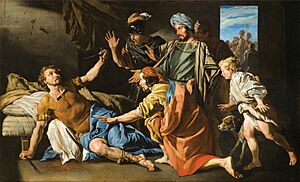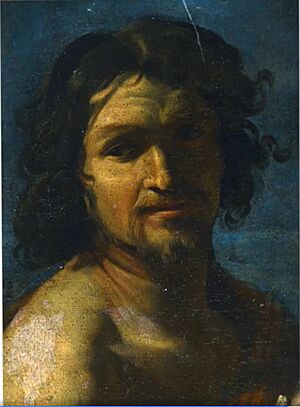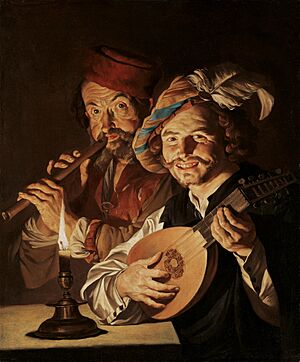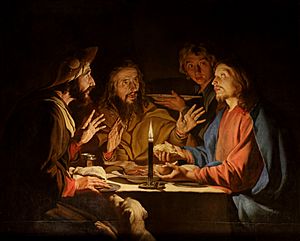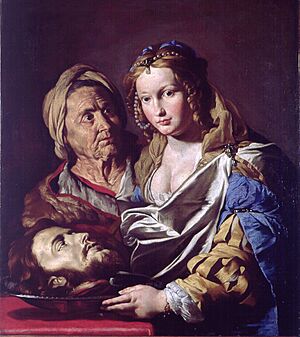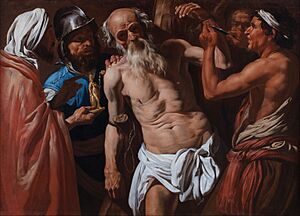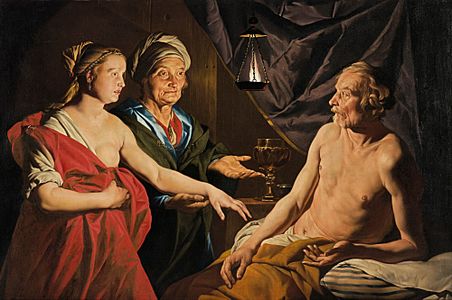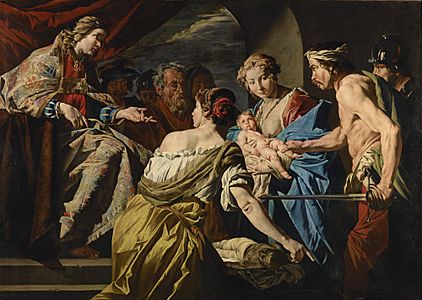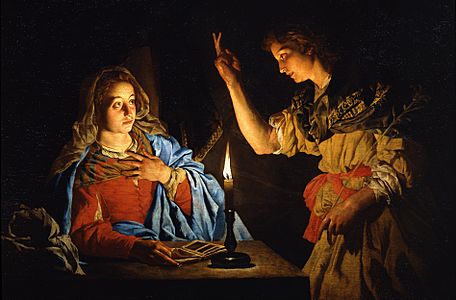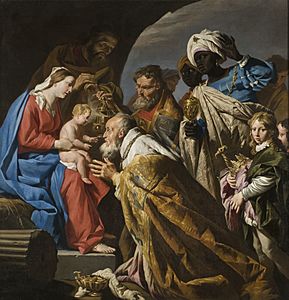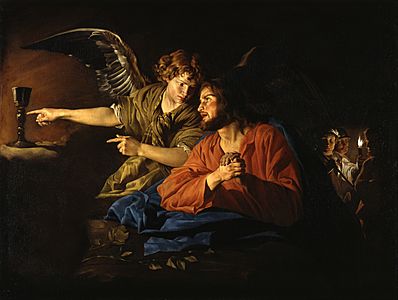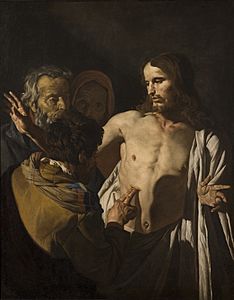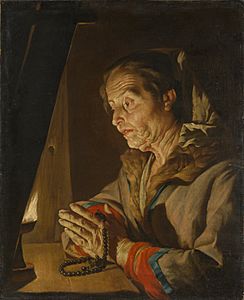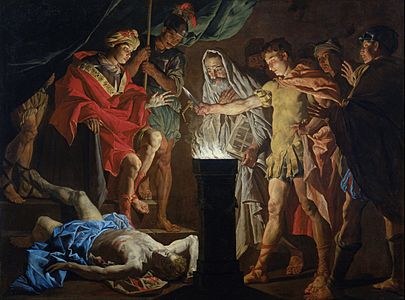Matthias Stom facts for kids
Matthias Stom (born around 1600, died after 1652) was a talented painter. He was either Dutch or Flemish, but we only know about the paintings he made while living in Italy. Stom was greatly influenced by other artists who followed the style of the famous Italian painter Caravaggio. These included Dutch painters known as the Utrecht Caravaggists, as well as Jusepe de Ribera and Peter Paul Rubens.
Unlike some other artists from the north who followed Caravaggio, Stom preferred to paint stories from the Bible. He did not often paint funny everyday scenes or complex symbolic pictures. He worked in different places across Italy and was supported by churches and important noble families.
For a long time, people called him Stomer, but it is now thought his real name was Stom, which is how he signed his paintings. Some believed his name "Stom" (which means "mute" or "dumb" in Dutch) was a nickname because they thought he couldn't speak. However, there is no proof that he had this disability.
Life of Matthias Stom
We don't know much about Matthias Stom's early life. We are not sure where he was born. In 1942, an art historian named G.J. Hoogewerff suggested Stom was born in Amersfoort, a city in the Netherlands. But he didn't say where he got this information, and there are no records of a "Stom" family in Amersfoort.
The name "Stom" was common in the Southern Netherlands (which is now Belgium). Most people with this name in the Dutch Republic at that time were immigrants from the south. This means Stom might have been Flemish himself, spending his early life and career there. Or, he could have been the son of immigrants who moved to the Dutch Republic.
People used to think Stom was a student of Gerard van Honthorst because their painting styles were very similar. However, Van Honthorst only returned to the Netherlands from Italy in 1620. It's unlikely Stom would have started learning from him when he was already 20 years old. It's possible Stom got extra training from Van Honthorst after learning elsewhere first.
He might also have trained with Hendrick ter Brugghen, another leading Caravaggio-style painter from Utrecht who came back from Italy in 1614. Or he could have learned from other painters like Joachim Wtewael, Paulus Moreelse, or Abraham Bloemaert. We don't have any official papers to confirm who Stom's teacher was. If Stom was Flemish, his painting style suggests he might have trained in the Southern Netherlands, possibly with Abraham Janssens, a Flemish painter who had studied in Italy. But again, there's no proof.
The first official record of Stom is from 1630. It states that "Mattheo Stom, a Flemish painter, 30 years old," was living in Rome with a French painter. This record helps us guess that Stom was born around 1600. He lived in Rome until 1632. A large painting called 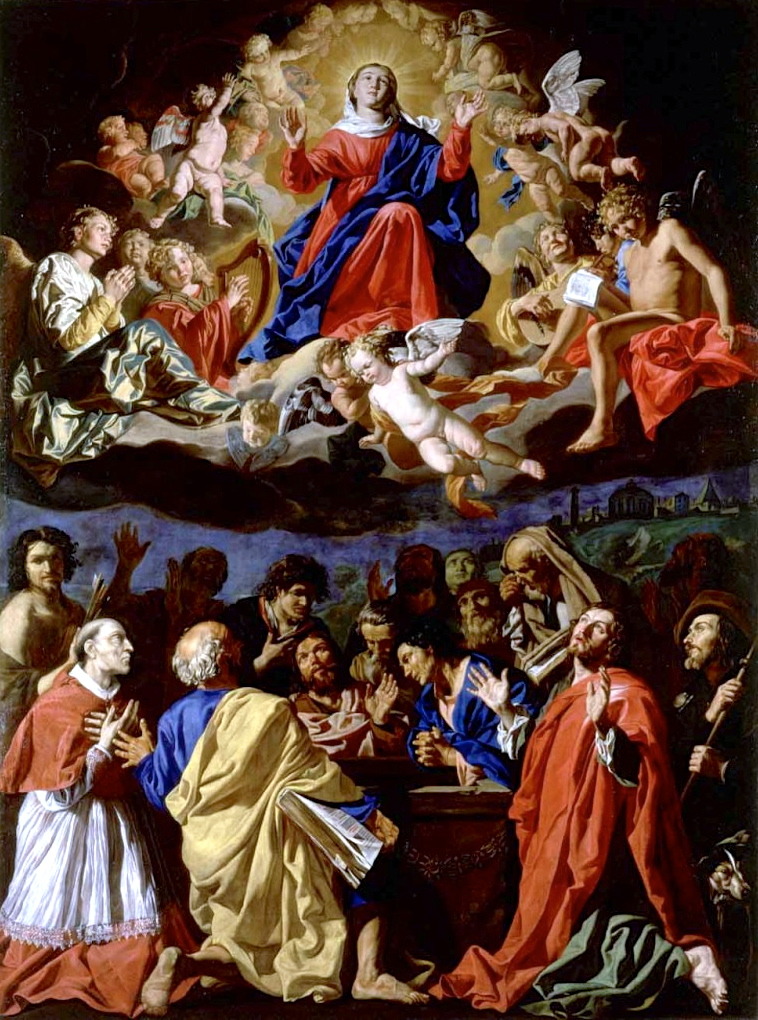 was made during his time in Rome. Some art historians believe the figure of Saint Sebastian in this painting is a self-portrait of Stom.
was made during his time in Rome. Some art historians believe the figure of Saint Sebastian in this painting is a self-portrait of Stom.
Before 1635, Stom left Rome and moved to Naples, where he stayed until at least 1640. In Naples, he was influenced by the Spanish painter Jusepe de Ribera, who also followed Caravaggio's style. His most important works from his time in Naples were a series of paintings about the Passion of Christ for a church. Sadly, these paintings were lost when the church became a prison in 1865. Stom likely influenced local painters like Domenico Viola and Domenico Gargiulo while in Naples. Records show he had a workshop there, as a student named Mattheus De Roggiero filed a court case against him.
Stom seemed to spend more time with other foreign sailors and Dutch people in Naples than with the local community. However, he still had many local supporters who bought his art. His paintings showing half-figures by candlelight, combining styles from Gerard van Honthorst and Rubens, were very popular. Stom's known paintings don't show much interest in the art of other Neapolitan painters of his time. He probably left Naples when his unique style was no longer new, as he didn't change his art to fit new trends.
In 1641, Stom was recorded in Palermo, Sicily, delivering paintings for churches. While in Sicily, he painted three pictures for Antonio Ruffo, a duke who collected many Italian, Flemish, and Dutch artworks.
Some of Stom's paintings were found in collections on the island of Malta. This suggests he had supporters there, but we don't know if he actually painted on Malta. The last known record of Stom working in Sicily is from 1649. We do not know when or where he died. He might have died in Sicily or in Northern Italy.
A painter named Matteo Stom or Matthias Stom the Younger made battle paintings in Northern Italy in the late 1600s. He might have been Matthias Stom's son or grandson.
Matthias Stom's Art Style
Stom spent most of his life as an artist in Italy. He created many paintings, and about 200 of them still exist today. He mostly painted stories from the New Testament and Old Testament of the Bible, as well as pictures of saints. He also painted some scenes from ancient history, myths, and everyday life.
It is said that Stom's painting style is very easy to recognize. His style didn't change much throughout his career. This might be why he was successful in different places: he brought his own unique style that was new wherever he went.
His work clearly shows influences from the Utrecht School of Caravaggisti, especially from Gerard van Honthorst. Van Honthorst was known in Italy as "Gherardo della Notte" (Gerard of the Night) because he often painted scenes lit by candles. Stom's paintings also often use a hidden candle or other light source to create dramatic chiaroscuro effects. Chiaroscuro is a strong contrast between light and dark.
Stom was also influenced by the Baroque art of Antwerp, especially by early followers of Caravaggio like Rubens and Abraham Janssens. All these artists were influenced by Caravaggio and his followers during their time in Italy. They all liked to use strong light and shadow in their art.
Stom's paintings often feature a single light source, like a candle, to create dramatic light and shadow. The colors red and yellow are often very strong in his work. The emotions in his scenes are made stronger by the lively hand gestures and facial expressions of the people he painted. He often showed life-sized figures from the waist up, very close to the viewer, to make you feel like you are part of the action.
Unlike Caravaggio, who used natural light and shadow, Stom often lit his scenes with the bright glow of a hidden candle or lamp. The faces in his paintings are very lively and often look like real portraits. Their expressions are made even stronger by their wrinkled faces, which are covered in strong light and shadow. His paintings show deep feelings in the people he portrays. The skin of his figures often looks like clay.
Gallery
- Selected works
-
Gaius Mucius Scaevola in the Presence of Lars Porsena
See also
 In Spanish: Matthias Stom para niños
In Spanish: Matthias Stom para niños


